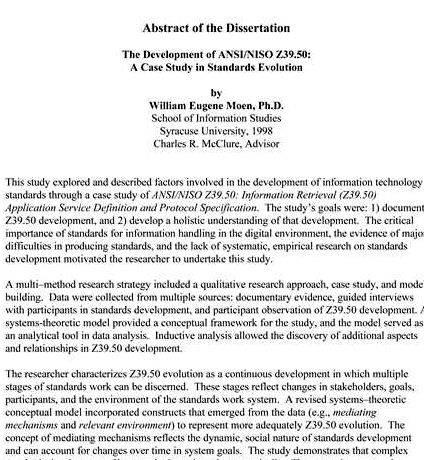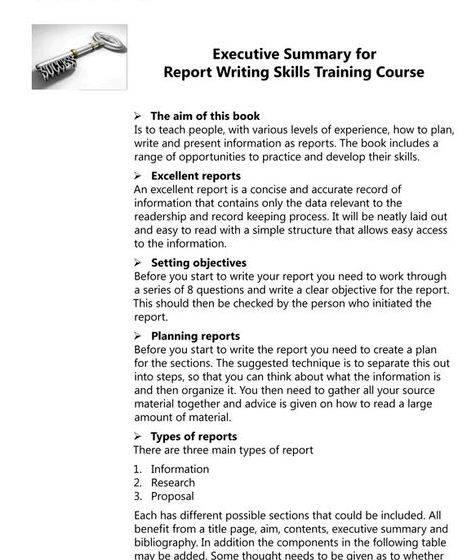

As its name suggests, an executive summary summarizes, or reviews the main points of, a longer document or report for a reader that does not have time to read the entire report. An effective executive summary analyzes and summarizes the most important points in the paper or report, and will often make a recommendation based on the analysis. Executive summaries are “stand alone” documents that are almost always read independently of the reports they summarize.
You may submit an executive summary as part of an assignment, and your instructor will likely read the summary and the paper or report. It’s helpful, however, to keep in mind that executive summaries should inform and influence people who will only be reading the executive summary. Most of the time, you will be summarizing a paper or report that you wrote, but there may be times when you will write an executive summary of another author’s report or article. Often your instructor will specify the length of your executive summary, but 10% of the document that you are summarizing is a good rule of thumb. For example, a ten-page paper or report would require a one-page executive summary.
When preparing to write an executive summary, ask yourself the following questions:
Who will read your executive summary? Sometimes your executive summary may have an “intended” audience: your professor might require you to write it for a CEO, department head, or supervisor, for example. On other assignments, your audience won’t have a specific identity, but always keep in mind that the reader of an executive summary needs to know all of the important information in the main document without reading the actual document. Even if you know that your instructor will be reading everything that you submit, write the executive summary as a “stand alone” document.

- What is the main document’s main topic, theme, or idea? Most reports have a “thesis” or central point that they are seeking to communicate. Try to sum this up in two or three sentences. If you are having trouble with this, imagine that someone has asked you, “what’s this report about?” and that you have to explain it in only a few sentences. Once you’re able to say what the main idea is, it will be easier to write it.
- What is the “purpose” of the main document? Most reports and papers have a reason, or a goal (beyond just fulfilling an assignment). Perhaps the report supports a change of opinion, new direction, or course of action. Try to summarize this in two or three sentences.
- Are there sections, or divisions, within the document? If so, which ones are the most important, or most crucial, to an understanding of the document? The kinds of documents that require executive summaries usually contain sections, or subtopics that support the main topic. There may even be headings that indicate what the sections will discuss. Try to decide which ones are necessary to an understanding of the issue at hand, and which ones can be left out.
- Does the document make a recommendation or suggest a certain course of action? Some documents argue in favor of a change, or urge the reader to follow a particular course of action. If this is the case, you can almost always find this information in the introduction or conclusion of a report, and the body of the report may discuss it in detail. Other documents do not contain a recommendation, but simply present data or research findings. In this case, you would need to analyze the data or research and recommend an action.

- What are the benefits or consequences of this course of action? Whether you comment upon the recommendation in the report or make a recommendation based on your analysis of the information in the report, be sure to include a discussion of why (or why not) the recommendation is a good idea. If there are benefits, state them, since this will help to make your recommendation more persuasive. Although you will want to emphasize the positive, be sure to mention any consequences.
Resources
As its name suggests, an executive summary summarizes, or reviews the main points of, a longer document or report for a reader that does not have time to read the entire report. An effective executive summary analyzes and summarizes the most important points in the paper or report, and will often make a recommendation based on the analysis. Executive summaries are “stand alone” documents that are almost always read independently of the reports they summarize.
You may submit an executive summary as part of an assignment, and your instructor will likely read the summary and the paper or report. It’s helpful, however, to keep in mind that executive summaries should inform and influence people who will only be reading the executive summary. Most of the time, you will be summarizing a paper or report that you wrote, but there may be times when you will write an executive summary of another author’s report or article. Often your instructor will specify the length of your executive summary, but 10% of the document that you are summarizing is a good rule of thumb. For example, a ten-page paper or report would require a one-page executive summary.
When preparing to write an executive summary, ask yourself the following questions:
Who will read your executive summary? Sometimes your executive summary may have an “intended” audience: your professor might require you to write it for a CEO, department head, or supervisor, for example. On other assignments, your audience won’t have a specific identity, but always keep in mind that the reader of an executive summary needs to know all of the important information in the main document without reading the actual document. Even if you know that your instructor will be reading everything that you submit, write the executive summary as a “stand alone” document.
- What is the main document’s main topic, theme, or idea? Most reports have a “thesis” or central point that they are seeking to communicate. Try to sum this up in two or three sentences. If you are having trouble with this, imagine that someone has asked you, “what’s this report about?” and that you have to explain it in only a few sentences. Once you’re able to say what the main idea is, it will be easier to write it.
- What is the “purpose” of the main document? Most reports and papers have a reason, or a goal (beyond just fulfilling an assignment). Perhaps the report supports a change of opinion, new direction, or course of action. Try to summarize this in two or three sentences.
- Are there sections, or divisions, within the document? If so, which ones are the most important, or most crucial, to an understanding of the document? The kinds of documents that require executive summaries usually contain sections, or subtopics that support the main topic. There may even be headings that indicate what the sections will discuss. Try to decide which ones are necessary to an understanding of the issue at hand, and which ones can be left out.
- Does the document make a recommendation or suggest a certain course of action? Some documents argue in favor of a change, or urge the reader to follow a particular course of action. If this is the case, you can almost always find this information in the introduction or conclusion of a report, and the body of the report may discuss it in detail. Other documents do not contain a recommendation, but simply present data or research findings. In this case, you would need to analyze the data or research and recommend an action.
- What are the benefits or consequences of this course of action? Whether you comment upon the recommendation in the report or make a recommendation based on your analysis of the information in the report, be sure to include a discussion of why (or why not) the recommendation is a good idea. If there are benefits, state them, since this will help to make your recommendation more persuasive. Although you will want to emphasize the positive, be sure to mention any consequences.
Resources
Previous answers to this question
This is a preview of an assignment submitted on our website by a student. If you need help with this question or any assignment help, click on the order button below and get started. We guarantee authentic, quality, 100% plagiarism free work or your money back.
 Get The Answer
Get The Answer